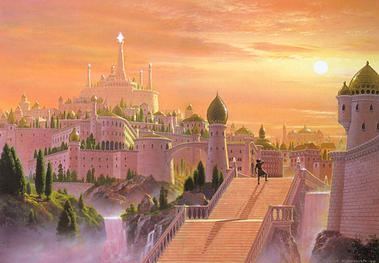Other name(s) Kôr | Location Valinor | |
 | ||
Type City of the Noldor
built on the hill of Túna Ruler Finarfin (present), Finwe and Fëanor (past) | ||
Tirion on tuna
In J. R. R. Tolkien's legendarium, Tirion upon Túna was the city of the Noldor (and earlier, the Vanyar, who later moved into Valinor's interior) in Valinor. It was from here that Finwë ruled, and where his sons Fëanor, Fingolfin and Finarfin lived.
Contents
- Tirion on tuna
- Let s play paper mario 1 50 tirion upon tuna
- History
- Kings
- Concept and creation
- References
Let s play paper mario 1 50 tirion upon tuna
History
The green hill of Túna was located in the steep-walled valley of Calacirya (translated from Quenya as "The Cleft of Light"), the only pass through the mountains of the Pelóri. Upon the crown of the hill the Elves raised their largest settlement west of the sea. The walls and terraces were white, and the sand in the streets was said to be of grains of diamond, and white crystal stairs climbed from the fertile land beneath to the great gates.
The centre of the city was dominated by Ingwë's tower, Mindon Eldaliéva, whose silver lantern shone far out to sea. Beneath the tower was the house of Finwë, first High King of the Noldor. Here also was the Great Square, where the white tree Galathilion flourished, and later the site of Fëanor's infamous oath.
After most of the Vanyarin elves resettled further into Valinor to Valmar and Taniquetil, the rule of Tirion was given to Finwë. From this time onwards, mostly Noldor lived in Tirion, though it is likely that as well some Teleri and Vanyar lived in the city at least as part-time residents, such as Finarfin's wife, the Telerin princess Earwen. Many years of bliss followed and it was during this time that Fëanor created the Silmarils. Afterwards Morgoth was released from 3 ages of imprisonment and after seeing them began to desire the Silmarils. He came to Tirion and told Fëanor lies about his younger brother, saying that Fingolfin desired to usurp Fëanor's position as heir to Finwë. It was because of this that Fëanor, after a heated argument with Fingolfin, drew his sword threatening his brother's life. And for this Fëanor was banished from Tirion by the Valar. Finwë went to Formenos with his elder son and Fingolfin became King of the Noldor in Tirion. After the murder of his father at the hands of Morgoth and the theft of his most precious gems, the Silmarils, Fëanor assembled the Noldor at the Great Square, where he urged the elves to leave with him back to Middle-earth to avenge their king and reclaim the Silmarils, and to see that their lives in Tirion were simply a prison brought upon them by the Valar. In the end only a tenth of the population remained when Fëanor, his brothers and his and their children departed, though some followed their new king only reluctantly, and some would soon after follow Finarfin back to Tirion.
Nearly 600 years passed before Tirion once again appears in the mythology. When all the kingdoms of the elves in Middle-earth were in ruins, Eärendil sailed into the west in search of Valinor to ask for the assistance of the Valar in the war against Morgoth. Eärendil arrived in Tirion on a day of festival in Valinor when the city was all but empty, and only when he had turned his back on the city and began to return was he approached by a herald of the Valar.
More than 3,000 years followed before Tirion was for the first time seen by mortal eyes—soldiers of the king of Númenor, deceived by Sauron, landed in on the shores of Eldamar and camped around Túna, which the fleeing elves emptied. When the men of Númenor were buried under falling hills, Tirion, along with all the Undying Lands, was taken out of mortal reach forever.
Kings
- Ingwë, First King, High King of all Elves
- Finwë, Second King.
- Fingolfin, second son of Finwë (gained kingship after Finwë left for Formenos to support Fëanor after his banishment).
- Fëanor, first son of Finwë (Nominally King after Finwë's death, before departure of Noldor for Middle-earth).
- Finarfin, third son of Finwë.
Concept and creation
This is found in the History of Middle-earth books edited by Christopher Tolkien and published by Harper Collins from 1983 to 1990, particularly in Volume I.
